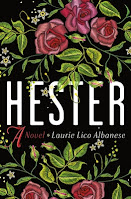I received this book for free from Netgalley. That did not influence this review.
Could there have been a real-life Hester Prynne?
In her new novel, Hester, Laurie Lico Albanese re-imagines The Scarlet Letter from the point of view of a fictional woman, Isobel Gamble. Isobel is a young Scottish immigrant to Salem in 1800. She has come to American with her much older husband, Edward, an apothecary addicted to opium. Almost immediately after their arrival, he abandons her to take a job as a ship’s doctor, dreaming of the riches he will find on the journey.
Isobel is a talented seamstress/embroideress. She is gifted, or perhaps cursed, with synesthesia, seeing colors in association with letters and speech. Synesthesia is poorly understood even today. Back then, it was seen as a form of madness. Or witchcraft. Having had relatives persecuted for witchcraft (and madness) back in Scotland, Isobel has been warned to keep her “colors” a secret. Nevertheless, they burst forth in the things she creates with her needle.
Isobel is a survivor. Despite being new to the city, alone, without means of support, and belonging to the unwelcome underclass of red-headed, thick-brogued foreigners, she finds work as a seamstress and makes a few friends. One of these friends is a handsome, bookish young man, Nathaniel Hathorne.
Nat is from old, established Salem society. Although his family is downwardly mobile, he’s still well-enough set up in life to spend his days struggling to become a writer. He is also struggling under the weight of his family history. His ancestor (also Nathaniel Hathorne) was one of the most persistent and unrepentant judges in the Salem witch trials. In this close-knit community, descendants of both accusers and accused continue to live side-by-side. Nat carries a lot of guilt. To some extent, he believes in the words thrown at his great-great-grandfather from the gallows: “A curse on you and your children and your children’s children – you’ll all die with blood in your throats.” He wants to put all that guilt, the darkness, into his writing.
Nat is a charmer, and Isobel needs some charm in her life. She feels a kinship with the other artist. He both praises her work and unthinkingly belittles it. He’s apologetic when Isobel calls him out on his condescension, but there is always something a little hollow in his words. Isobel recognizes his self-absorption, but excuses it. And when it seems as though her husband will not be returning from sea, a secret she keeps to herself, she and Nat begin an affair. Who seduces whom? Neither. It is clearly something they both want. But they are looking for two different things. Isobel wants a partner. Nat wants a muse.
The novel is lushly written. Tales of persecuted witches and condemning clergymen/judges are interspersed throughout, fleshing out the inter-generational trauma that shapes both Isobel and Nathaniel. (For me, these were the weakest parts, simply because I felt like I’ve heard these same stories too often.) There is also a concurrent story of the horrors of the slave trade. There is a free Black population in Salem, but freedom is tenuous and only recently “granted.” Bounty hunters roam the streets looking for escaped slaves. Prejudice, narrow-mindedness, hypocrisy, and greed are the norm rather than the exception.
And yet, Isobel’s indomitable spirit succeeds in making this a hopeful, triumphant story.
Did Nathaniel Hawthorne take inspiration from a “Hester” of his own? This novel will leave you believing that he did.














This sounds like a fun way to reconsider The Scarlet Letter.
ReplyDeleteI read and enjoyed this book too. I found it very immersive in the era and ambitious in including several difficult themes.
ReplyDeleteTerrie @ Bookshelf Journeys